
Next-Level Touchless Technology
March 10, 2021 | By Doug Picklyk
The evolution of electronically-controlled hands-free fixtures is leading to the connected Smart Washroom.
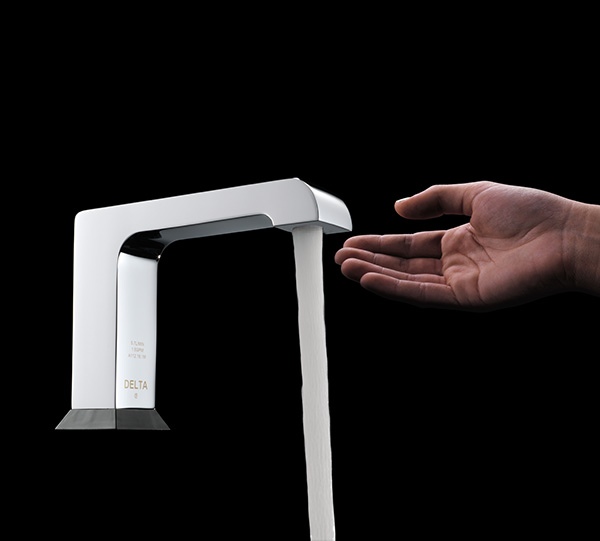
With increased awareness and focus on individual hygiene and societal pressure to reduce the public spread of germs and viruses, a renewed focus has been placed on touchless fixtures for the washroom—especially in high-traffic venues like healthcare, airports, education facilities, office buildings and any public gathering spaces.
Beyond the function of convenience and safety, today’s hands-free fixtures are also providing enhanced energy and water efficiency benefits, and the addition of networked connectivity to the electronics in these faucets and flush valves is driving these plumbing fixtures to the onramp of the Internet of Things.
Demand Rising
The worldwide COVID-19 pandemic has facilitated the immediate retrofit of many common points of contact in commercial venues, from automatic doors and contactless payments, to plexiglass dividers in retail and restaurant settings to ensure safe distancing. Of course the washroom, a prime location for cross-contamination, has attracted additional attention and demand for hands-free fixtures.
“For sure, demand has been skyrocketing,” says Marlon Thompson, senior marketing manager, American Standard brand, for Lixil Canada. “Wherever you can eliminate touchpoints, especially in a commercial washroom environment, that’s the key.”
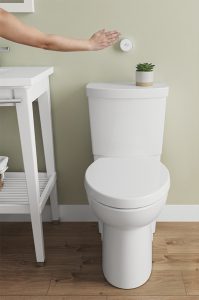
American Standard’s new Studio Touchless Toilet with wave sensor. The 2-1/2-in. sensor module can be placed up to three feet away from the toilet.
The company has a broad range of touchless fixtures for the commercial market, but its most recent innovation has been on the residential side. “We’ve had touchless on the tank of toilets, and we’ve just released a product based on radio frequency, so now you can place the sensor up to three feet away,” says Thompson.
Moving from infrared (line-of-sight) on the tank to touchless radio frequency provides greater accessibility for some users. “It helps people with mobility issues, enabling placement of the activation where it’s most convenient for the user,” he explains.
“Right now we’re launching this in the residential market, but we’re working on taking this technology into the commercial segment.”
He could foresee applications in assistive living establishments, places where the elderly and/or handicapped individuals call home.
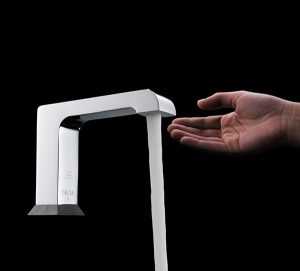
Delta’s Proximity faucet senses without optical sensors.
For high-volume public spaces, manufacturers are also improving their sensing technology for more reliable service.
Proximity sensing technology from Delta commercial faucets is designed for facilities that require hands-free operation, vandal resistance and ease of maintenance. The entire faucet body acts as a sensor, so there are no sensor windows or optical parts to maintain on the fixture.
Recent enhancements to the platform include improved resistance to electrical signal noise and power fluctuations; a redesigned control box that is modular and more compact; and expanded power options including plug-in and “less power” models for more cost-efficient ganging applications.
Powered
Some form of electrical power is required to drive the operation of handsfree fixtures. In commercial spaces the faucets and flush valves are now often hard wired when installed, but battery-operated fixtures are also in demand.
“It just doesn’t make sense to use battery-operated, especially in high-frequency areas like airports,” suggests Thompson. Although American Standard does offer its PWRX 10-year battery system (at 4,000 uses per month) for selected commercial urinal and toilet flush valves.
Zurn offers a broad selection of sensor faucets and flush valves for the institutional, commercial and industrial (ICI) market, including both battery and hard-wired options.
While new builds favour hard-wire installation, the flexibility of batteries is seeing more interest. “There are a lot of buildings that are transitioning to touchless now—for the obvious health and hygienic reasons—and it’s much easier to do a retrofit or convert a washroom to touchless if you don’t have to break tiles, call an electrician and run wire,” says Adam Findlay, digital sales manager with Zurn Canada
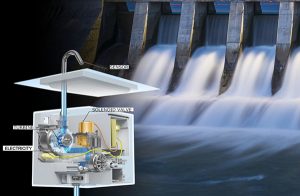
TOTO has introduced internal turbines to power its touchless faucet and flush valve’s electronics.
Manufacturers are working to make their touchless technology even more eco-friendly. In January, at the virtual 2021 Consumer Electronics Show (CES), TOTO shared details of its ECOPOWER technology that harnesses the energy of the running water to power its smart-sensor faucets and flush valves, eliminating the need for hard-wiring or routine battery replacement.
The self-powered hydroelectric flush valve systems and touchless faucets generate power every time water turns their internal turbine. Toto says no daily usage minimum is required.
Other eco-friendly features built into many touchless fixtures on the market include pre-set control of flow rates, temperature and precise run times. These automatic setting make the faucets and flush valves water saving devices.
Connected
The next step in fixture automation is leading to the ‘smart’ washroom. “Everyone in the industry see’s the connected washroom as a big opportunity,” says Thompson from American Standard.
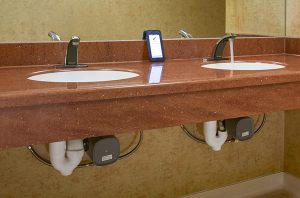
Sloan Connect introduces Bluetooth connectivity to the company’s touchless fixtures.
Sloan, recognized for its commercial products and focus on sustainability, has introduced wireless communication to its product line.
“One of the great things about wireless technology like Sloan Connect is that there are no special requirements to install the products,” says Mark Lawinger, Sloan senior product line manager, flushometers and fixtures.
“The one incremental step is to download the Sloan Connect app and learn how to communicate with the Bluetooth-enabled products. This is also simple and intuitive and only requires the user to wave their hand in front of the sensor three times to initiate the connection.”
The connectivity also provides convenience in the set up. “Once the product is installed, plumbing contractors can change settings and run diagnostics through the app,” notes Faye Badger, Sloan product line manager, IoT. “This saves them time and is far more convenient than working under a sink to change parameters/settings. The diagnostic capabilities through Sloan Connect also save time in determining the health of a product. For example, plumbers know the battery power percentage. They can now change the batteries when they need to be replaced instead of on a time basis.”
The improved visibility is also key for facility managers to monitor the health of their systems, and the app allows facilities to schedule an automatic line flush to run faucets or flush toilets (activate flushometers). “This helps to keep the water in the lines fresh and helps prevent stagnant water issues” adds Badger. “Automatic line flush ability is particularly important now as many buildings are not being used due to COVID-19.”
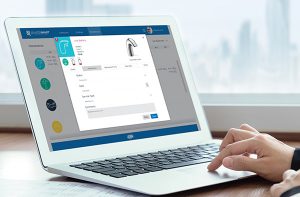
The new PlumbSmart platform from Zurn sends fixture data to the cloud.
Zurn recently introduced its new connected platform called PlumbSmart to the Canadian market. According to Findlay, who is charged with leading the roll out, the platform has been operating in the U.S. for over a year, providing a great benchmark for user experiences and positive case studies.
“The connection process is quite simple,” adds Findlay. A small transmitting endpoint is installed with each fixture, including a full complement of battery or hard-wired products including touchless flush valves and faucets as well as backflow protection valves.
The connected products communicate with a local gateway in the building, which then relays the data, via an ethernet or wireless internet connection to the cloud where the PlumbSmart application harvests the data and then relays the information to the end-user’s computer, iPad or cell phone.
The connected fixtures use a low-frequency signal able to penetrate walls and floors in multi-level buildings, and it’s also fully encrypted and secured for safety. The range of the gateway is roughly 1,000-feet.
“There are very few products like this in the market,” notes Findlay, adding that the benefits for building owners and facility managers include more targeted maintenance routines, real-time alerts—especially critical for backflow valves—and greater insight into water consumption and usage patterns.
“For maintenance companies, they can see at a glance how many restrooms are operating, or if there are any issues,” says Findlay. And based on experience so far, Zurn indicates buildings can see up to 30% improvement in reduced maintenance and operational costs, and up to 25% improvement in eco-friendly savings.
“Further product development and growing the list of connected products is top of mind for us,” adds Findlay, “The platform will grow as we find what’s applicable for our customers and how we can help them.”
The trend towards connected fixtures for the commercial and residential washroom markets adds a new layer of high-tech into the ever-evolving plumbing industry. <>




